Welcome, fellow wanderers, to Multan – a city where tales of ancient warriors, mystic saints, and timeless architecture converge to create a tapestry rich with cultural heritage. Nestled in the heart of Pakistan’s Punjab province, Multan, often hailed as the “City of Saints,” beckons travelers with its captivating blend of history, spirituality, and vibrant local life. Let’s embark on a journey through this magnificent city, where every corner tells a story.
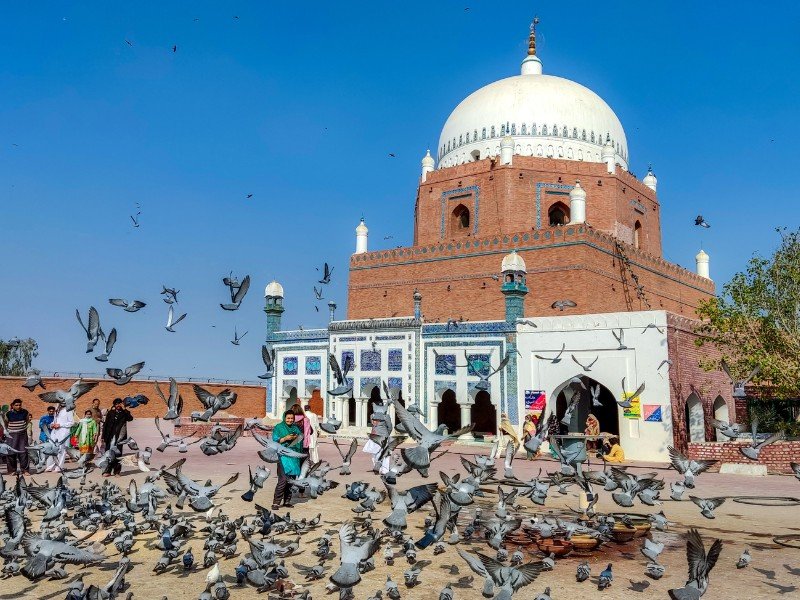
A City Steeped in Legend
Multan’s roots delve deep into the annals of time, with legends whispering of its existence for millennia. This city isn’t just old; it’s ancient, with a history that stretches back over 5,000 years. It’s a place where the air is thick with tales of conquests, where the great Alexander the Great once tread, and where Sufi saints chose to leave their indelible marks.
Walking through Multan is akin to traversing the pages of a mystical manuscript. The city is dotted with tombs and shrines dedicated to Sufi saints, each a marvel of architectural beauty and spiritual solace. The Mausoleum of Shah Rukn-e-Alam, with its stunning blue tiles, not only serves as a beacon for pilgrims from all around but also stands as a testament to the city’s spiritual significance.
But Multan is more than just its spiritual allure. It’s a city that bursts at the seams with culture and tradition. From the bustling bazaars filled with the famous Multani handicrafts to the mouthwatering aroma of traditional Punjabi cuisine, the city offers a feast for the senses. The vibrant markets, selling everything from intricate blue pottery to handwoven carpets, reflect the artistic soul of Multan.
The Culinary Journey
No visit to Multan would be complete without indulging in its culinary delights. The city’s food landscape is a mirror to its diverse history, offering flavors that are as rich and complex as its past. From the tangy zest of Multani Sohan Halwa to the spicy depth of traditional BBQ, every dish invites you on a gastronomic adventure.
One of Multan’s most endearing qualities is the warmth and hospitality of its people. Visitors are embraced with open arms, treated to stories, and often, invited to share a meal. It’s this genuine warmth that turns a visit into an experience, leaving travelers with memories that are as heartfelt as they are timeless.
Ready to Explore?
As you venture through Multan, let its history envelop you, its spirituality move you, and its culture delight you. This city, with its layers of stories, awaits to share its secrets with those eager to listen. Whether you’re a history buff, a spiritual seeker, or simply in love with exploring new cultures, Multan offers a journey that’s as enriching as it is unforgettable. Welcome to Multan, where every moment is a discovery.

Multan City Guide: A Brief History Of Multan, Pakistan
The story of Multan is as old as the hills – or, more accurately, as ancient civilizations. Archaeological finds suggest that this vibrant city has been around for over 5,000 years, making it one of the oldest living cities in the Asian subcontinent. Imagine, if you will, a place that has witnessed the ebb and flow of human civilization, from the Indus Valley Civilization to the modern era.
A Confluence of Cultures
Through the ages, Multan has been a magnet for conquerors and seekers alike. It was here that Alexander the Great extended his empire, leaving behind traces of Greek influence. The city flourished under various dynasties – from the Mauryans to the Guptas, and then the Ghaznavids, Mughals, and Sikhs, each adding a layer to Multan’s cultural landscape. This is a city that has seen empires rise and fall, each leaving a lasting imprint on its identity.
But it’s the arrival of Sufism that perhaps most deeply defined Multan’s character. The city became a center for spiritual learning and devotion, earning its moniker as the “City of Saints.” It’s home to the shrines of revered Sufi saints like Bahauddin Zakariya and Shah Rukn-e-Alam, whose teachings continue to draw pilgrims from all over the world. Their mausoleums, architectural marvels in their own right, stand as beacons of peace and serenity.
The Siege of Multan
The historical narrative of Multan is punctuated by the Siege of Multan in 1848, a turning point that marked the British Empire’s consolidation in the region. This event wasn’t just a battle; it was a moment of transformation that ushered in a new era in Multan’s story, intertwining its destiny with the colonial tapestry of the Indian subcontinent.
Through every era, Multan has shown a remarkable resilience, reinventing itself while preserving its heritage. Post-independence, the city emerged as a cultural and economic hub in Pakistan’s Punjab province, thriving amidst modernity while keeping its ancient spirit alive.
Today, Multan stands as a testament to its past, a city where history breathes through the walls of its forts, the silence of its shrines, and the buzz of its bazaars. It’s a place where the past and present meld seamlessly, offering a unique glimpse into the soul of Pakistan.
In Multan, every stone tells a story, every alley holds a legend, and every sunset by the Chenab River feels like a journey through time. This is Multan – a city not just to be visited, but to be experienced, felt, and remembered.
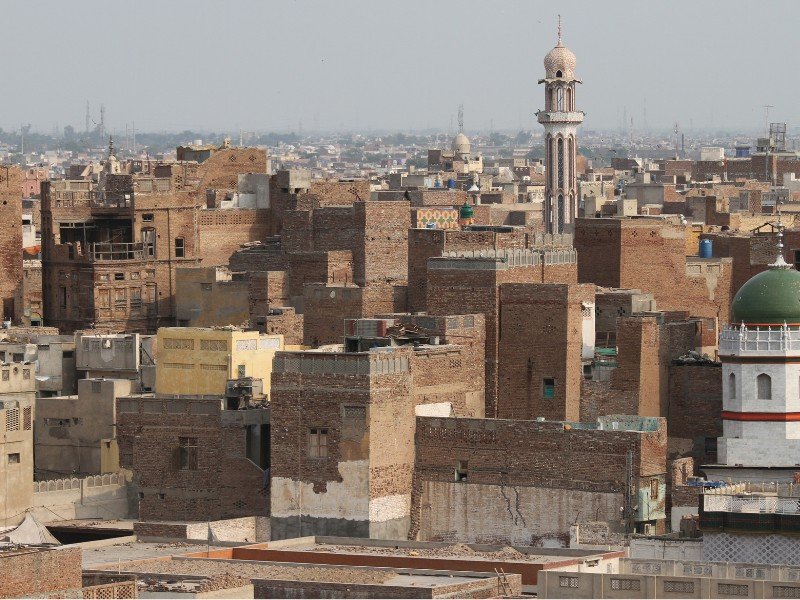
Top Attraction In Multan For Visitors
Introduction
Home to people since 5000 BC, Multan is one of the world’s oldest cities. It has extensive ties to Sufi Islam, with multiple shrines to various saints and religious figures found here. If you look closely, you’ll see remnants of a fort that was among the mightiest in South Asia.
In a word, this place is cultural traveller heaven. So, grab a mango (they are famous for those too) and your camera, and get going – there’s a lot to see!
Come check out our Multan travel guide as we cover the best things to do in Multan, Punjab, Pakistan.
Top Attractions
Begin your tour of Multan by visiting the Tomb of Shah Rukne Alam. The final resting place for the Sufi saint of the same name, it is a truly spectacular space. It embodies the essence of Tughluq architecture, a style of building that was last seen in India during medieval times.
Its trademark elements include its buttresses and its tile work, the latter of which is unique to Multan. In the evening, the exterior of the tomb is lit up, so return after dark if night photography is your thing.
Within the mausoleum, you’ll find the grave of Shah Rukne Alam, along with 72 of his relatives. If possible, try to time your visit to this city during the Urs Festival. At this time, more than 100,000 pilgrims flood the tomb to pay homage to this religious figure.
Next, make your way to the Tomb of Bahauddin Zakariya. The Sufi mystic built this structure prior to his death in the 13th century. Constructed of red brick, its style set the standard for shrines that marked the landscape of south Punjab.
As you walk around the complex, you may notice pieces of string tied to its gates. These are mannat, or the hopes of devotees who pray to various figures (like Bahauddin Zakariya). As you enter, the mood will get entrancing, as you watch Sufis engage in song and dance rituals. Do try to take these in, as this is one of the more unique sects in Islam.
More Attractions
When you are ready to move along, make the Shrine of Shah Yusuf Gardezi your next destination. According to local lore, Yusuf Gardezi came to the Multan area in the 11th century from Afghanistan. Historians laud this saint for “saving” the city by performing miracles and converting people to Islam.
The shrine’s builders covered it with the blue tile work Multan is famous for. Inside, you’ll get to see Ayina Kari, a form of decoration that uses mirrors. As beautiful as this place is, however, keep your wits about you. Locals report that pickpockets operate here, preying on distracted tourists. Keep valuables in your front pockets, and you should be fine.
For centuries, Fort Kohna defended the perimeter of Multan. Historians maintain that the original fort ringed this city from as early as 1000 BC. It stood up to many invaders before falling to the artillery of Maharaja Ranjit Singh in the 19th century.
However, the fort remained in use until later that century. In the mid-19th century, the British overwhelmed these defences completely, leaving them in ruins. Locals restored what remained, leaving what exists in the present day.
Around the city limits of Old Multan, gates and sections of the wall still stand. If you have time, try to see them all.
Other Attractions
If you have time to see more shrines, slot the Tomb of Shah Shams Sabzwari Tabrez into your itinerary. Built to honour the Persian Sufi missionary of the same name, he was most famous for the poetry that he wrote.
Wishing to see their grandfather immortalized, his grandsons of Sabzwari Tabrez built him a shrine in the 14th century. Boasting the ornamental tiles that other mausoleums in Multan have, it is a beautiful place, but not wholly essential.
Low on time, but want to check out the highlights of the old fort walls of Multan? Go see Delhi Gate. Named because it faced Delhi, India, it is a grand brick gate that the British used to enter Multan. In the vicinity of this monument are many shops and old Turkish-style baths. Take your time and experience them – that’s the beauty of travel!
Unwind from the chaotic streets of Multan by visiting Yadgar e Shuhada Park. Built to honour the martyrs that died in service of Pakistan, it is not a typical municipal park. However, planners have set aside some space for families to enjoy picnics. Get some local food from a stall and join them!
When the weather isn’t cooperating with your travel plans, salvage the day by visiting United Mall. While it isn’t the biggest mall in Pakistan, it does have its share of international brands. After you’ve stocked up on essentials, grab a meal in its food court. Just be careful of the bathrooms – their cleanliness isn’t equal to western standards.
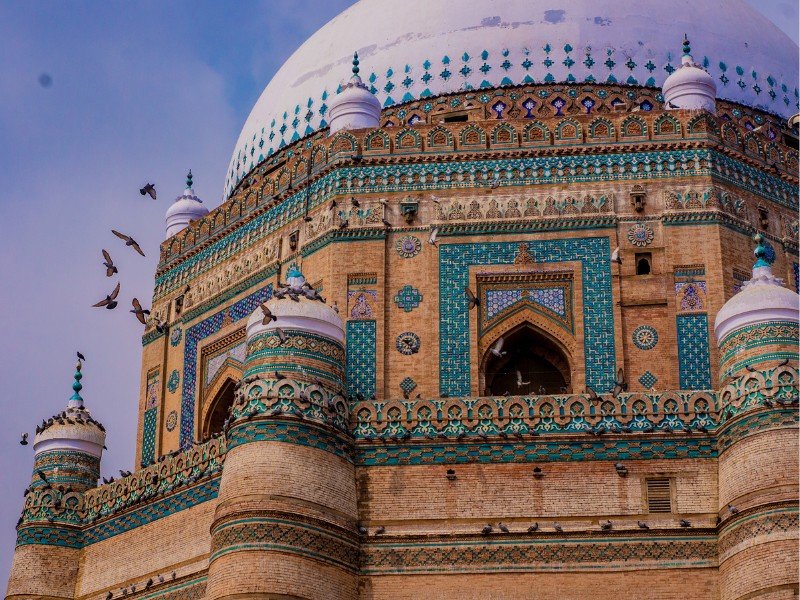
Top 25 Things To Do in Multan, Pakistan For Visitors
Here are the top 25 things to do in Multan:
1. Visit the Shrine of Bahauddin Zakariya
Explore the stunning Shrine of Bahauddin Zakariya, a 13th-century Sufi saint renowned for his teachings. This magnificent mausoleum showcases intricate blue Kashi tiles and a majestic dome that captivates visitors. Immerse yourself in the spiritual ambiance and learn about Sufi traditions that have shaped the region. Don’t miss the annual Urs festival, which celebrates the saint’s life with vibrant cultural events.
- Architectural marvel: Admire the intricate blue Kashi tile work.
- Spiritual experience: Feel the serene atmosphere of the shrine.
- Cultural festivities: Attend the Urs festival for a unique celebration.
2. Explore the Multan Fort
Step back in time at the historic Multan Fort, with its ancient ramparts and gates telling tales of bygone eras. Wander through remnants of this once-impenetrable fortress, including the impressive Damdama, the main surviving gateway. Enjoy panoramic views of the city and discover shrines and mosques within its boundaries. Despite centuries of wear, the fort remains a symbol of Multan’s resilience and rich history.
- Historic exploration: Traverse the ancient fortifications.
- Scenic views: Capture breathtaking vistas of Multan.
- Cultural landmarks: Visit shrines and mosques within the fort.
3. Admire the Shah Rukn-e-Alam Shrine
Marvel at the Shah Rukn-e-Alam Shrine, renowned for its striking architecture and spiritual significance. This 14th-century mausoleum stands out with its octagonal base, high dome, and intricate tile work. Considered a masterpiece of Islamic architecture, it’s a focal point for pilgrims worldwide. The serene atmosphere inside offers a moment of reflection and peace.
- Architectural beauty: Appreciate the shrine’s unique design.
- Spiritual haven: Experience the tranquility within the mausoleum.
- Pilgrimage site: Join visitors from around the globe.
4. Discover the Ghanta Ghar
Visit Ghanta Ghar, the Clock Tower of Multan, a historic landmark and central point for city exploration. Surrounded by bustling markets, it’s the perfect starting place for shopping and sightseeing. Immerse yourself in local life and culture as you navigate the lively streets. Nearby bazaars offer traditional crafts and delicious street food you won’t want to miss.
- Historic centerpiece: See the iconic Clock Tower up close.
- Shopping hub: Explore markets brimming with local goods.
- Culinary delights: Taste authentic Multani street food.
5. Visit the Tomb of Shamsuddin Sabzwari
Pay your respects at the Tomb of Shamsuddin Sabzwari, a significant Sufi saint’s resting place by the Ravi River. Known for its tranquil setting and beautiful mausoleum architecture, it’s a peaceful retreat. Join pilgrims and tourists who visit to honor the saint and enjoy the serene surroundings. The annual Urs festival here attracts devotees from various regions.
- Peaceful atmosphere: Relax in the calm environment.
- Architectural elegance: Admire the mausoleum’s design.
- Cultural significance: Learn about the saint’s impact on the region.
6. Walk Through Haram Gate
Stroll through Haram Gate, one of the original entry points into the ancient Multan Fort. This gate stands as a fascinating relic, offering insight into the city’s medieval defenses and architectural styles. Explore the area for excellent photography opportunities and a sense of Multan’s historical grandeur. The gate’s preservation provides a tangible link to the past.
- Historical walk: Step through a gateway to history.
- Photography spot: Capture images of the ancient architecture.
- Cultural insight: Understand the city’s defensive structures.
7. Explore the Multan Museum
Delve into the region’s rich history at the Multan Museum, housing artifacts from ancient to modern times. Exhibits include Indus civilization relics, Islamic art, coins, manuscripts, and armory. Gain valuable insights into the lives and traditions of people who have inhabited Multan over millennia. It’s an educational experience for history enthusiasts and curious travelers alike.
- Historical artifacts: See relics from various eras.
- Cultural education: Learn about Multan’s diverse heritage.
- Interactive exhibits: Engage with the museum’s collections.
8. Experience the Hussain Agahi Bazaar
Immerse yourself in the vibrant Hussain Agahi Bazaar, one of Multan’s oldest markets. Shop for traditional handicrafts like Multani khussa (leather shoes), blue pottery, and intricate embroidery work. Savor local street food specialties as you navigate the bustling stalls. The bazaar’s lively atmosphere and colorful offerings make it a shopper’s paradise.
- Traditional crafts: Find unique, handmade souvenirs.
- Local cuisine: Taste delicious street food.
- Bustling atmosphere: Experience the energy of a traditional market.
9. Relax at the Shah Shams Park
Unwind at Shah Shams Park, a well-maintained green space perfect for escaping the city’s hustle and bustle. Enjoy leisurely walks along landscaped gardens and walking paths. The park features children’s play areas, making it a popular spot for families. It’s an ideal place to picnic, relax, and enjoy nature within Multan.
- Nature retreat: Enjoy the tranquility of the park.
- Family-friendly: Let kids play in designated areas.
- Scenic beauty: Appreciate the well-kept gardens.
10. Enjoy the Multan Sultans at the Multan Cricket Stadium
Catch the excitement of a cricket match at the Multan Cricket Stadium, home to the Pakistan Super League’s Multan Sultans. As one of the country’s premier venues, it hosts both domestic and international games. Experience the passion and energy of Pakistani cricket firsthand. The stadium’s modern facilities ensure a comfortable and thrilling outing.
- Sporting event: Watch a live cricket match.
- Team spirit: Cheer for the Multan Sultans.
- Vibrant atmosphere: Feel the crowd’s electrifying energy.
11. Visit the Ibn-e-Qasim Bagh Stadium
Explore the historic Ibn-e-Qasim Bagh Stadium, a sports complex nestled within the ancient walls of Multan Fort. Hosting cricket, football matches, and cultural festivals, it offers a unique blend of modern sports in a historic setting. Attend an event here to experience a fusion of past and present.
- Historic venue: Enjoy events in a storied location.
- Diverse activities: Attend sports or cultural festivals.
- Unique experience: Witness modern events amid ancient walls.
12. Admire the Beauty of the Delhi Gate
Marvel at the Delhi Gate, another historic entrance to Multan Fort known for its architectural beauty. This gate has stood witness to centuries of the city’s evolution. Nearby, find a mix of traditional shops and modern cafes, blending old and new. It’s an excellent backdrop for photography and a gateway to exploring Multan’s heritage.
- Architectural gem: Appreciate the gate’s intricate design.
- Cultural blend: Explore surrounding shops and cafes.
- Photographic hotspot: Capture stunning images.
13. Experience Local Cuisine at Multani Restaurants
Satisfy your taste buds with Multan’s rich and flavorful cuisine at local restaurants. Indulge in spicy meat curries and sweet Sohan Halwa, a local delicacy. Street food vendors offer authentic Multani flavors that are a delight for foodies. Sampling these dishes is a must-do to truly experience the city’s culinary scene.
- Flavorful dishes: Enjoy traditional Multani meals.
- Sweet treats: Try the famous Sohan Halwa.
- Culinary exploration: Dive into the local food culture.
14. Take a Boat Ride on the Chenab River
Embark on a peaceful boat ride on the Chenab River, offering refreshing views and a serene experience. The riverbanks are lined with lush greenery, making it a picturesque journey. It’s a relaxing way to spend an afternoon, especially during cooler months. Enjoy the natural beauty of Punjab from a unique vantage point.
- Scenic journey: Admire landscapes from the water.
- Relaxing activity: Unwind on a gentle boat ride.
- Nature appreciation: Connect with the region’s environment.
15. Pray at the Eidgah Mosque
Visit the Eidgah Mosque, an important religious site known for its architectural beauty and spiritual atmosphere. Hosting large congregations during Eid festivals, it becomes a focal point for the Muslim community. The mosque’s open courtyard and classic Islamic design make it a serene place for prayer and reflection.
- Spiritual site: Experience the mosque’s peaceful ambiance.
- Architectural beauty: Observe classic Islamic features.
- Community gathering: Witness local religious practices.
16. Shop for Multani Handicrafts
Support local artisans by shopping for Multani handicrafts, including pottery, textiles, and metalwork. These handmade items make unique and authentic souvenirs. Explore markets and specialty shops offering a wide selection of traditional crafts. Each piece reflects the city’s artistic heritage and craftsmanship.
- Unique souvenirs: Find one-of-a-kind items.
- Artisan support: Help preserve traditional crafts.
- Cultural connection: Take home a piece of Multan’s heritage.
17. Discover the Mausoleum of Shah Ali Akbar
Explore the Mausoleum of Shah Ali Akbar, a beautiful shrine dedicated to a revered Sufi saint. The intricate tile work and calligraphy showcase exquisite Islamic art. The shrine offers a peaceful space for prayer and contemplation. Visiting provides a deeper understanding of Multan’s Sufi traditions and spiritual history.
- Artistic details: Admire the intricate decorations.
- Peaceful retreat: Enjoy a moment of serenity.
- Spiritual heritage: Learn about Sufi practices.
18. Visit the Multan Public Library
Enrich your knowledge at the Multan Public Library, housing a vast collection of books and historical documents. It’s a quiet place for reading, research, and learning about the region’s culture. The library often hosts literary events and cultural programs. It’s an educational stop for those keen on history and literature.
- Extensive collection: Access a wealth of information.
- Quiet study: Find a peaceful spot to read.
- Cultural events: Participate in literary gatherings.
19. Enjoy the Festivities at the Multan Cultural Festival
Join the celebration at the Multan Cultural Festival, an annual event showcasing the city’s rich heritage. Enjoy music, dance, art, and delicious food during this vibrant festival. Performances by local artists and craft exhibitions highlight Multan’s traditions. It’s a fantastic way to immerse yourself in local culture.
- Live performances: Watch traditional music and dance.
- Art exhibitions: View works by local artisans.
- Culinary delights: Taste a variety of regional dishes.
20. Explore the Local Art Scene at the Multan Art Gallery
Visit the Multan Art Gallery, a hub for contemporary art showcasing works by local and national artists. The gallery hosts exhibitions, workshops, and events promoting creativity. Admire paintings, sculptures, and installations reflecting Pakistan’s modern art scene. It’s an inspiring destination for art lovers.
- Contemporary works: See modern artistic expressions.
- Creative space: Engage with the local art community.
- Inspiring exhibits: Find inspiration in diverse artworks.
21. Walk Through the Nishtar Park
Take a leisurely stroll in Nishtar Park, a large green space offering tranquility amid the city. The park features landscaped gardens, walking paths, and sports facilities. It’s a popular spot for morning walks, family outings, and outdoor activities. Enjoy the fresh air and peaceful surroundings.
- Outdoor relaxation: Unwind in natural beauty.
- Active pursuits: Utilize sports and walking facilities.
- Family time: Perfect for group outings.
22. Attend a Performance at the Multan Arts Council
Experience the local arts scene at the Multan Arts Council, hosting theater productions, concerts, and exhibitions. Attending a performance offers insight into the city’s cultural vibrancy. The council plays a key role in preserving and promoting Multan’s artistic heritage.
- Theatrical shows: Enjoy plays and performances.
- Musical concerts: Listen to live music by talented artists.
- Cultural preservation: Support the local arts community.
23. Visit the Tomb of Bibi Pak Daman
Pay homage at the Tomb of Bibi Pak Daman, dedicated to a revered female saint known as “the chaste lady.” The shrine is a place of spiritual solace and reflection. Visitors come to seek blessings and experience the peaceful environment. It embodies the spiritual heritage of Multan.
- Spiritual reflection: Find peace within the shrine.
- Cultural significance: Learn about the saint’s legacy.
- Quiet contemplation: Enjoy a moment of tranquility.
24. Relax at the Multan Tea House
Unwind at the Multan Tea House, a traditional spot where locals gather to enjoy tea and conversations. Engage in discussions about politics, literature, and social issues with residents. The tea house offers a variety of traditional Pakistani teas and snacks. It’s a cozy place to experience the city’s social life.
- Local ambiance: Immerse yourself in daily life.
- Friendly chats: Meet and converse with locals.
- Delicious teas: Savor traditional Pakistani brews.
25. Discover the Mausoleum of Hazrat Hafiz Muhammad Jamal Multani
Visit the Mausoleum of Hazrat Hafiz Muhammad Jamal Multani, dedicated to a respected Sufi saint. The shrine showcases beautiful Islamic architecture adorned with intricate tile work and calligraphy. It’s a serene place that embodies the spiritual essence of Multan, offering peace to all who enter.
- Architectural splendor: Marvel at the mausoleum’s design.
- Spiritual journey: Feel the sanctity of the shrine.
- Cultural depth: Appreciate the city’s Sufi heritage.
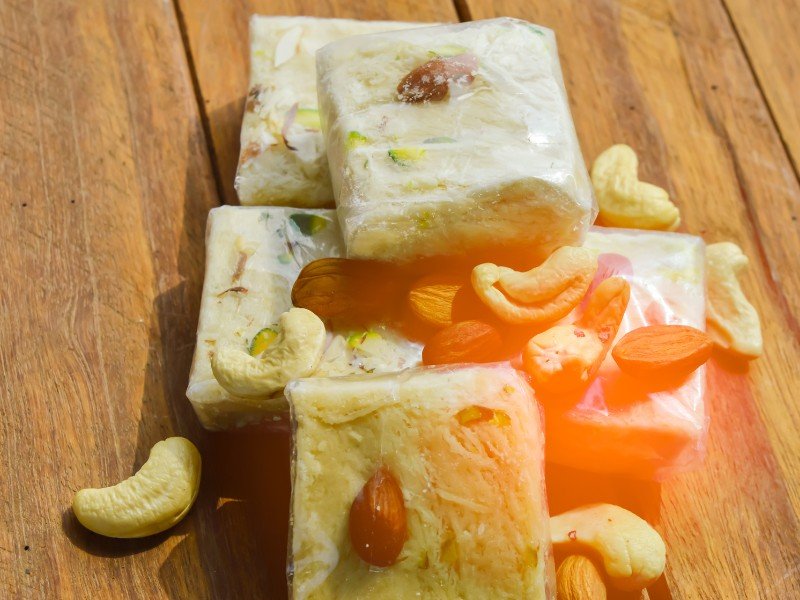
What To Eat and Drink in Multan, Pakistan
If you’re venturing into this enchanting city, your trip wouldn’t be complete without diving into the local cuisine. Let me take you through a gastronomic tour of Multan, where every dish tells a story, and every sip is a celebration of flavors.
The Signature Delights
Multani Sohan Halwa
Starting with the sweet, let’s talk about Multan’s pride – Sohan Halwa. This dense, sweet confection, made from milk, sugar, and flour, and garnished with nuts, is a heavenly delight. It’s not just a dessert; it’s a piece of Multan’s soul, a must-bring-back souvenir for anyone visiting.
Multani Mangoes
Summers in Multan are synonymous with mangoes. Known as the king of fruits, the mangoes here are unparalleled in sweetness and variety. Sipping on a fresh mango juice or indulging in the succulent slices is a ritual in itself during the mango season.
A Taste of Tradition
Multani Biryani
Moving on to the savory, Multani Biryani offers a unique twist on the traditional biryani, with its rich flavors and aromatic spices. It’s a perfect blend of rice, meat (usually chicken or beef), and a secret mix of spices that gives it a distinct taste from other regional biryanis.
Sarson ka Saag and Makki di Roti
A winter specialty, this dish is a warm hug on a cold day. Sarson ka Saag (mustard greens curry) paired with Makki di Roti (cornbread) is a traditional Punjabi meal that you’ll find in the heart of Multan’s culinary scene. It’s rustic, hearty, and deeply satisfying.
Street Food Adventure
Chaat and Samosas
No trip to Multan is complete without sampling the street food. The chaat here, with its mix of tangy tamarind sauce, yogurt, and crispy puris, is a flavor bomb. And the samosas? Crispy on the outside, spicy and savory on the inside – perfect for a quick snack as you explore the city.
Multani Fish Fry
A special mention goes to the Multani Fish Fry, a delicacy that’s not to be missed. Freshwater fish is marinated in a blend of local spices and then deep-fried to perfection. It’s crispy, flavorful, and a testament to Multan’s love for good food.
Quench Your Thirst
Sugarcane Juice
To beat the heat and refresh yourself, nothing beats a cold glass of sugarcane juice. It’s sweet, hydrating, and utterly refreshing. A popular choice among locals, it’s a simple pleasure that embodies the essence of Multani summers.
Lassi
Lastly, no meal in Multan is complete without a glass of Lassi. This traditional yogurt-based drink can be sweet or salty and is the perfect antidote to the spicy fare. It’s not just a drink; it’s a tradition that soothes the soul and cools the body.
The Culinary Soul of Multan
As you wander through this historic city, let your taste buds lead the way. From the bustling bazaars serving street food to the elegant restaurants offering traditional meals, Multan promises a culinary journey that’s as memorable as the city itself. So, come hungry and leave with your heart and stomach full, carrying the taste of Multan with you wherever you go.

Tours For Visitors To Multan, Pakistan
To truly immerse yourself in the essence of Multan, joining a guided tour can be an enlightening experience. Whether you’re a history aficionado, a spiritual seeker, or a lover of traditional crafts, Multan offers a variety of tours that cater to every interest. Let me guide you through some of the best tour experiences that will make your visit to this ancient city unforgettable.
Historical and Cultural Excursions
The Spiritual Trail
Embark on a tour that takes you through the revered shrines and Sufi saints’ mausoleums that dot the city. The Spiritual Trail is not just a tour; it’s a journey into the soul of Multan. Visit the Mausoleum of Shah Rukn-e-Alam and the Shrine of Bahauddin Zakariya, where you can experience the tranquility and learn about Sufi traditions that have permeated the city for centuries.
Architectural Marvels Tour
For architecture enthusiasts, the Architectural Marvels Tour is a must. From the grandeur of the Multan Fort to the intricate blue tiles of the mosques and tombs, this tour offers a deep dive into the city’s rich architectural heritage. Guides often share fascinating stories behind each structure, bringing the stones and bricks to life.
Culinary Adventures
Multan Food Tour
A visit to Multan is incomplete without indulging in its culinary delights. The Multan Food Tour takes you on a flavorful journey through the city’s bustling bazaars and street food corners. From tasting the legendary Multani Sohan Halwa to savoring the spicy delights of local kebabs and biryanis, your taste buds are in for a treat. This tour not only fills your stomach but also offers insights into the traditions behind each dish.
Artisan and Craft Tours
The Blue Pottery Experience
Multan is renowned for its exquisite blue pottery. The Blue Pottery Experience allows you to visit the workshops where this beautiful craft is still alive. Watch artisans at work, learn about the process behind each masterpiece, and maybe try your hand at creating your own. It’s a unique opportunity to witness a traditional craft that has been passed down through generations.
Nature and Leisure Tours
The Green Side of Multan
For those looking to explore the natural beauty around Multan, The Green Side of Multan tour offers a refreshing escape. Visit the lush gardens like the Cantonment Garden and the serene banks of the Chenab River. It’s a perfect way to relax and soak in the peaceful atmosphere of the city’s green spaces.
Personalized Experiences
Customized Tours
For travelers looking for a more personalized experience, there are several tour operators in Multan who offer customized tours tailored to your interests. Whether it’s exploring the local art scene, diving deeper into the history, or discovering hidden gems in the city, a customized tour can be designed to suit your curiosity.
Preparing for Your Tour
When embarking on these tours, it’s advisable to wear comfortable shoes, carry water, and have your camera ready to capture the moments. Engaging with local guides not only enriches your tour experience but also supports the local economy. Don’t hesitate to ask questions and share your experiences with fellow travelers.
Multan, with its blend of history, spirituality, and culture, offers a plethora of experiences waiting to be explored. Through these tours, visitors can gain a deeper understanding and appreciation of the city’s heritage. So, lace up your shoes, and get ready to explore Multan like never before.
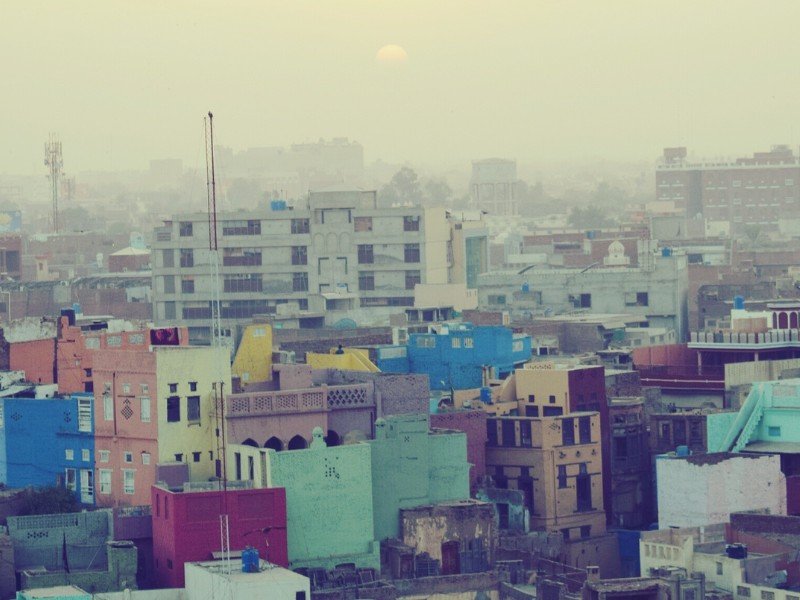
Multan Accommodations Guide: Hotels, Guesthouses and Hostels
Finding the perfect place to stay is crucial for a memorable visit. Luckily, Multan offers a variety of accommodations to suit every traveler’s need, from the lap of luxury to budget-friendly hostels. Here’s your guide to navigating the accommodations in Multan, ensuring you find the perfect base for your adventures.
Luxurious Retreats
The Grand Luxe Experience
For those looking to indulge in luxury, Multan has several high-end hotels that offer world-class amenities and impeccable service. These establishments often feature spacious rooms, on-site restaurants serving exquisite local and international cuisine, serene spa facilities, and swimming pools to beat the heat. Notable mentions include the Ramada by Wyndham Multan and the S Chalet Multan, where elegance meets comfort, providing an oasis of tranquility amidst the bustling city life.
Mid-Range Comfort
The Happy Medium
If you’re seeking comfort without the luxury price tag, mid-range hotels in Multan offer a delightful balance of quality and value. These hotels provide comfortable rooms, essential amenities, and often a taste of local hospitality that can make your stay memorable. The Hotel One Multan, for instance, is known for its friendly service and convenient location, making it a favorite among regular visitors to the city.
Budget-Friendly Stays
Hostels and Guesthouses
For backpackers and budget-conscious travelers, Multan’s hostels and guesthouses are the way to go. These accommodations offer the basics you need at prices that won’t break the bank. What they might lack in luxury, they more than make up for in character and the opportunity to meet fellow travelers. Places like the Bloom Star Hotel offer simple, clean rooms and a friendly atmosphere, perfect for those looking to explore Multan without spending a fortune.
Traditional Guesthouses
A Taste of Local Life
For a truly authentic experience, staying in a traditional guesthouse can be a unique opportunity to experience Pakistani hospitality. These family-run establishments provide a cozy, home-like atmosphere, often including homemade meals and the chance to engage with local traditions up close. While not as common as hotels, these gems can be found with a bit of research and often provide a more personal and enriching stay.
What to Consider When Choosing Your Stay
- Location is Key: Consider staying near the city center or close to the main attractions you plan to visit. Multan’s traffic can be unpredictable, so minimizing travel time can enhance your experience.
- Book in Advance: Especially during peak tourist seasons or festival times, accommodations can fill up quickly. Booking ahead ensures you get your preferred choice.
- Read Reviews: Before making your decision, read up on recent guest reviews to get a sense of what to expect from your stay. These insights can be invaluable in setting the right expectations.
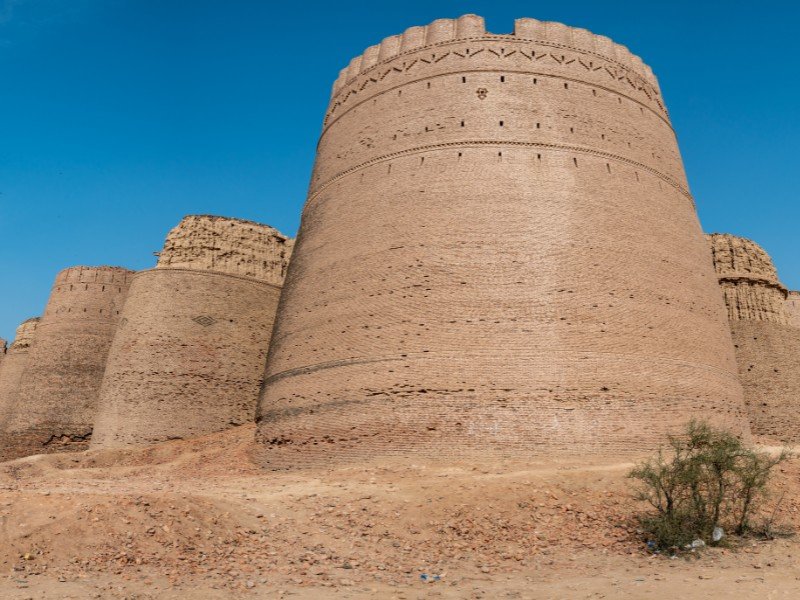
Day Trips From Multan, Pakistan
The region surrounding Multan is ripe with destinations that offer a glimpse into the rural heartlands, majestic landscapes, and historical sites of Pakistan. If you’re looking to expand your horizons beyond the city, here are some day trips from Multan that promise to enrich your travel experience with new discoveries and unforgettable memories.
Bahawalpur: The Royal City
A Glimpse into Royalty
Just a couple of hours’ drive from Multan lies Bahawalpur, a city that boasts a regal past and architectural marvels that speak of its princely heritage. Don’t miss the Noor Mahal, a stunning palace that combines European and Indian architectural styles. While you’re there, the Bahawalpur Museum and the lush Lal Sohanra National Park are also worth a visit, offering insights into the region’s biodiversity and history.
Uch Sharif: The Ancient City
Spiritual and Historical Journey
About an hour’s drive from Multan, Uch Sharif is a hidden gem for those interested in Sufism and ancient architecture. This UNESCO-listed site is home to some of the most beautiful tombs and shrines of Sufi saints, dating back to the 12th and 17th centuries. The intricate Islamic calligraphy and blue tiles make Uch Sharif a photographer’s paradise.
Derawar Fort: The Desert Fortress
Adventure in the Cholistan Desert
Nestled in the heart of the Cholistan Desert, about a three-hour drive from Multan, the majestic Derawar Fort stands as a testament to the region’s rich history. Its massive bastions and the unique marquee-shaped architecture are awe-inspiring. A visit here is often coupled with a desert safari, giving you a taste of the vast, sandy landscapes that characterize this part of Pakistan.
Harappa: The Cradle of Civilization
Time Travel to the Indus Valley
For history buffs, a day trip to Harappa is like traveling back in time to one of the world’s earliest urban settlements. Located about three hours from Multan, the ancient city of Harappa offers a fascinating insight into the Indus Valley Civilization with its well-planned streets and sophisticated drainage systems. The Harappa Museum here displays artifacts unearthed from the site, providing a deeper understanding of this ancient culture.
Tips for Your Day Trips
- Start Early: To make the most of your day, start early. This gives you ample time to explore without rushing.
- Hire a Local Guide: For places like Uch Sharif and Harappa, having a local guide can greatly enhance your understanding of the historical and cultural context.
- Pack Accordingly: Remember to pack essentials like water, snacks, and sunscreen, especially for trips into the desert areas.
- Check Local Conditions: Some areas, especially those in the desert, can be seasonal or have specific visiting hours. It’s always best to check ahead.
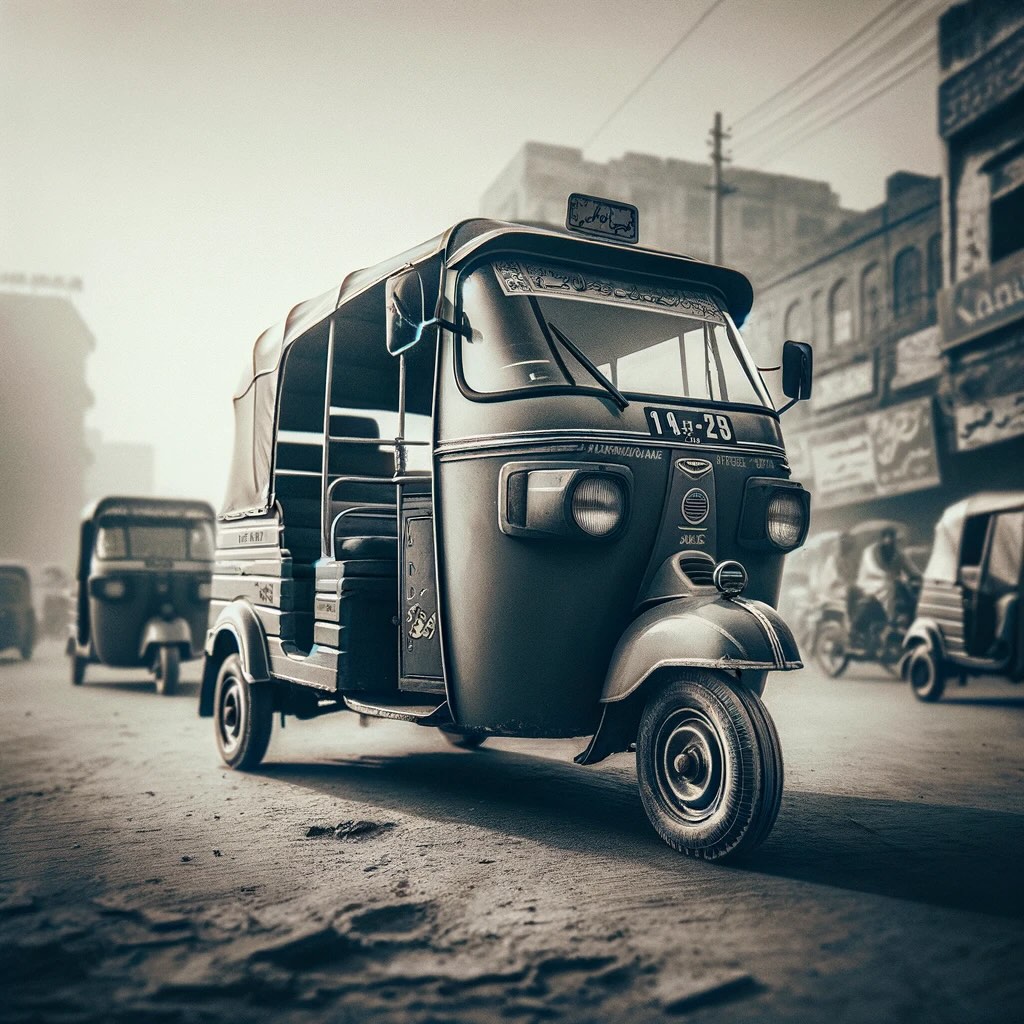
Multan Transportation Guide
Whether you’re here to explore its ancient forts, seek spiritual solace, or dive into the local culture, getting around is part of the journey. Here’s your go-to guide for making sense of the transportation maze in Multan, ensuring you can explore every nook and cranny without a hitch.
Touching Down: From the Airport to the City
The Gateway to Multan
Landing at Multan International Airport, you’re just a ride away from the heart of the city. Taxis and ride-hailing services like Careem and Uber are readily available outside the terminal. For a more local experience, rickshaws can also whisk you into the city, offering a first-hand glimpse into the bustling life of Multan.
Getting Around: Your Options
Auto Rickshaws: The Local Charm
Auto rickshaws are the lifeblood of local transportation in Multan. They’re everywhere, ready to zip you through the narrow alleys and crowded bazaars. Negotiate the fare before you hop in, and you’re set for an authentic ride.
Taxis and Ride-Hailing Apps
For those seeking a bit more comfort, taxis and ride-hailing apps offer a convenient way to get around. They’re especially handy when the temperatures soar, and the air-conditioned ride becomes a sanctuary from the heat.
Buses: The Pulse of the City
Multan’s bus network is an affordable way to travel longer distances within the city. While the bus routes cover extensive areas, they can be a bit challenging for first-timers to navigate. A little local assistance goes a long way here.
Bicycles and E-bikes
For the environmentally conscious and adventure-seeking travelers, bicycles and e-bikes are emerging as a fun way to explore Multan at your own pace. Some guesthouses and hostels offer rental services, giving you the freedom to weave through the city’s historical lanes.
Tips for Smooth Sailing
- Embrace the Pace: Traffic in Multan can be unpredictable. Embrace the local pace of life and factor in some extra time for your travels.
- Stay Hydrated: The heat in Multan can be intense, especially if you’re not used to it. Always carry water with you, no matter how short the journey.
- Keep Small Change Handy: For rickshaws and buses, having small change can save time and hassle.
- Safety First: While Multan is relatively safe, it’s wise to keep your belongings secure, especially in crowded places.
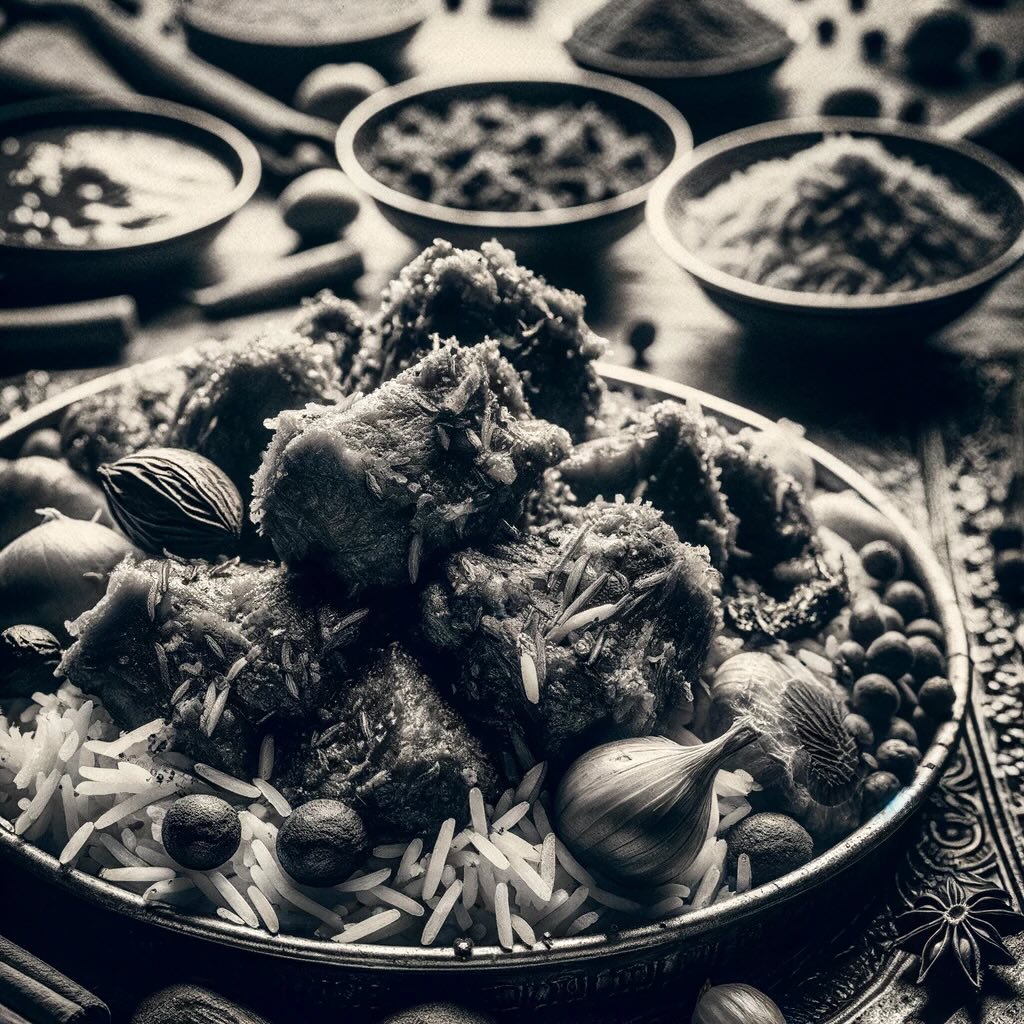
Multan 3-4 Days Travel Itinerary
If you’re planning to explore this ancient city over 3-4 days, you’re in for an experience filled with spiritual depth, architectural marvels, and culinary delights. Here’s how to make the most of your time, ensuring a trip that’s as enriching as it is unforgettable.
Day 1: Dive into the Heart of Multan
Morning: The Spiritual Beginnings
Kick off your Multan adventure at the Mausoleum of Shah Rukn-e-Alam, one of the most revered Sufi sites in the city. The stunning architecture and serene atmosphere provide a perfect introduction to the spiritual depth of Multan. From there, wander over to the nearby Mausoleum of Bahauddin Zakariya, further immersing yourself in the city’s Sufi heritage.
Afternoon: Architectural Wonders
After a local lunch featuring some of Multan’s famous dishes, like mutton karahi or biryani, head to the Multan Fort. Explore the remnants of this ancient fortress, taking in panoramic views of the city from Damdama. The Fort’s museum offers a peek into Multan’s rich history, from its military significance to its cultural treasures.
Evening: Sunset and Local Cuisine
End your day at the Ghanta Ghar, where you can watch the city light up as the sun sets. This area is buzzing with food stalls and restaurants, making it the perfect spot to sample street food like chaat or samosas, followed by a sweet serving of Multani Sohan Halwa.
Day 2: Art, Culture, and Leisure
Morning: Dive into History
Start your day with a visit to the Multan Museum, where you can deepen your understanding of the region’s history and culture. From ancient artifacts to modern artworks, the museum offers a comprehensive look at Multan’s journey through time.
Afternoon: Craftsmanship and Shopping
After grabbing lunch, venture into the bustling markets of Multan. Hussain Agahi Bazaar is a treasure trove of local handicrafts, textiles, and the famous Multani blue pottery. It’s the perfect place to pick up souvenirs and gifts, immersing yourself in the vibrant local commerce.
Evening: A Taste of Multan
Spend your evening enjoying a traditional dinner at one of Multan’s renowned restaurants. This is your chance to dive deeper into the local cuisine, perhaps trying out dishes like saag and makki di roti, or the grilled delicacies at a BBQ hotspot.
Day 3: Nature and Relaxation
Morning: Green Escapes
Take a leisurely start to your day with a visit to the Cantonment Garden or the Jinnah Park. These green spaces offer a tranquil escape from the city’s hustle and bustle, perfect for a relaxed morning stroll.
Afternoon: The Banks of the Chenab
In the afternoon, take a short drive out to the banks of the Chenab River. The serene landscapes and the gentle flow of the river provide a beautiful backdrop for a picnic or a leisurely walk, allowing you to soak in the natural beauty surrounding Multan.
Optional Day 4: Exploring Beyond Multan
If you have an extra day, consider a day trip to nearby historical or natural sites. Uch Sharif, with its ancient Islamic architecture, or the Bahawalpur city with its Noor Mahal, offer fascinating glimpses into the region’s past. Alternatively, a trip to the Lal Sohanra National Park can be a refreshing day spent amidst nature.
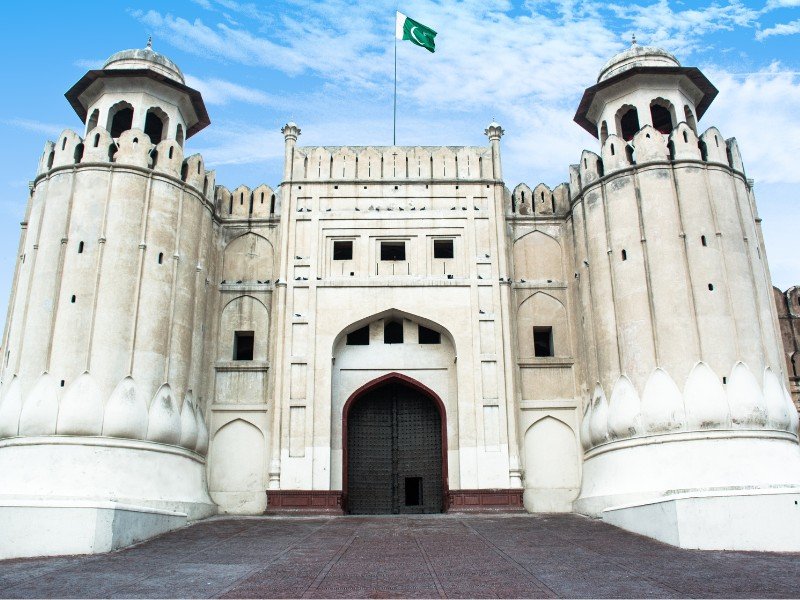
Where To Visit After Your Trip To Multan?
After immersing yourself in the spiritual ambiance and cultural richness of Multan, you might wonder, “What’s next on my travel itinerary?” Fortunately, Pakistan is a land of diverse landscapes, historic sites, and vibrant cities, each offering its own unique experiences. Whether you’re craving more historical adventures, natural beauty, or bustling city life, there’s a next stop waiting for you. Here’s a guide to help you decide where to head after your enriching journey through Multan.
Lahore: The Cultural Heartbeat
A Blend of History and Modernity
Just a few hours’ drive from Multan, Lahore awaits with open arms, offering a blend of historical grandeur and modern vibrancy. Known as the cultural capital of Pakistan, Lahore is home to the majestic Lahore Fort, the serene Shalimar Gardens, and the iconic Badshahi Mosque. Don’t miss the chance to wander through the old city, savoring the famous Lahore street food and shopping for handicrafts in Anarkali Bazaar. Lahore’s rich history, coupled with its contemporary arts scene and culinary delights, makes it a must-visit.
Islamabad and Rawalpindi: The Twin Cities
Contrasts and Harmony
A bit further afield, the twin cities of Islamabad and Rawalpindi offer a fascinating contrast of experiences. Islamabad, with its modern layout and lush greenery, provides a serene environment and attractions like the Faisal Mosque and the Pakistan Monument. Meanwhile, Rawalpindi boasts a bustling atmosphere with its lively markets and traditional eateries. Together, they present a blend of Pakistan’s past and present, tradition and progress.
Northern Pakistan: A Natural Wonderland
The Road Less Traveled
For those willing to venture further, Northern Pakistan is a realm of unparalleled natural beauty. Start your journey in Gilgit-Baltistan, where the enchanting Hunza Valley, the breathtaking Attabad Lake, and the towering Rakaposhi peak await. This region is a paradise for trekkers, nature enthusiasts, and anyone looking to disconnect and immerse themselves in the tranquility of nature. The Karakoram Highway, one of the world’s highest paved roads, offers an unforgettable journey through some of the most dramatic landscapes on earth.
Karachi: The City of Lights
Urban Exploration
If you’re yearning for a taste of urban life, Karachi, the country’s economic hub, is your next stop. Situated on the coast of the Arabian Sea, Karachi is a city of contrasts, from the bustling Port of Karachi to the tranquil Clifton Beach. Explore the city’s diverse heritage at sites like the Quaid-e-Azam’s Mausoleum, the Pakistan Maritime Museum, and the vibrant Saddar Town. Karachi’s culinary scene, bustling markets, and dynamic cultural life offer endless opportunities for exploration.
Sindh’s Historical Gems
Tracing Ancient Civilizations
Travelers with a passion for history might consider exploring deeper into Sindh. The ancient city of Mohenjo-Daro, a UNESCO World Heritage Site, provides a fascinating glimpse into one of the world’s oldest civilizations, the Indus Valley Civilization. Meanwhile, the city of Thatta with its historic Shah Jahan Mosque and the nearby Makli Necropolis offers insights into the region’s rich Islamic heritage.
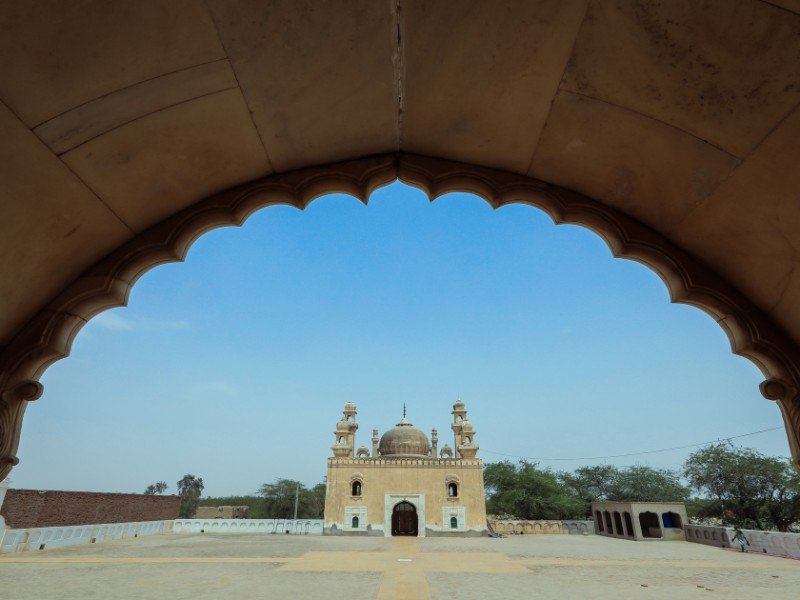
Essential Questions About Visiting Multan, Pakistan: Practical Answers, Cultural Etiquette & Trip-Planning Tips
What’s the best time of year to visit Multan without melting (or choking on smog)?
Absolutely. Timing matters here. Multan is famous for intense heat, with late spring and summer often hitting extreme temperatures, so sightseeing can get punishing fast.
For the most comfortable exploring, aim for late autumn through early spring. October to March is the sweet spot for walking the old city, hopping between shrines, and lingering in bazaars without feeling like you’re in a hair dryer.
One caveat: Punjab can get seasonal smog in cooler months, so if air quality is a concern, keep an eye on forecasts and consider building in flexible indoor plans.
How many days do I actually need in Multan?
It depends. You can hit the headline shrines and the fort in 2 days, but I think 3 days is the happy balance. That gives you time to explore Old Multan’s gates and markets, visit the museum, and eat your way through the city without rushing.
If you love spiritual history, architecture, or photography, 4 days lets you slow down and add a day trip to places like Uch Sharif or Bahawalpur.
Is Multan safe for tourists right now?
Generally, yes — with smart precautions. Like many big South Asian cities, Multan has areas that feel calm and welcoming and others that demand more awareness. Official travel advisories for Pakistan often highlight risks such as terrorism and the need for extra caution in certain regions; they also encourage travelers to stay alert and follow local guidance.
On the ground, your most realistic day-to-day concerns are the usual: pickpocketing in crowded bazaars, phone snatching, and occasional overcharging. Keep valuables minimal, use reputable transport, and avoid aimless late-night wandering in unfamiliar districts.
Is Multan a good destination for solo women travelers?
Yes — with planning. Sufi shrine culture is often welcoming and family-oriented, and you’ll likely encounter a lot of respectful curiosity. I’d recommend modest clothing, a light scarf for religious sites, and choosing well-reviewed hotels that can help with taxis or trusted drivers.
If you’re solo, daytime exploration and guided shrine/food walks can make the experience smoother and more comfortable.
What should I know before visiting Sufi shrines and mosques?
Absolutely. A little etiquette goes a long way. Dress modestly, remove shoes where required, and ask before photographing people at prayer. At some shrines, you may see devotees tying strings or making requests — observe respectfully even if it’s unfamiliar.
I also like to keep small bills handy for donations and to avoid awkward change situations.
How do I get to Multan from other cities in Pakistan?
You’ve got a few solid options. Multan International Airport connects with major hubs, and domestic flights can be a time-saver if you’re short on days.
Train travel is also a classic Pakistan experience. Multan Cantonment is a key rail station serving major routes, so it can be an affordable and scenic way to arrive.
What’s the easiest way to get around Multan day-to-day?
Auto-rickshaws are everywhere and great for short hops, but always agree on a price up front. For comfort, especially in heat, app-based rides where available can remove the bargaining drama.
Multan also has a Metrobus system that connects key parts of the city, which can be helpful if your accommodation sits near a station and you want a low-cost option.
Which shrines are truly unmissable if I’m short on time?
Not really a trick question — these are the big two.
If you only have one day for sacred architecture, prioritize:
- Mausoleum of Shah Rukn-e-Alam
- Shrine of Bahauddin Zakariya
They’re iconic for a reason: the scale, the tile work, the atmosphere, and the sheer sense of history. I’d also add a wander through nearby old-city lanes to feel how spiritual life and daily life weave together.
What are the best markets for Multani handicrafts and souvenirs?
Absolutely. Multan is a shopping delight if you like artisan goods. Head to the historic bazaars around the old city, especially areas that specialize in:
- Blue pottery
- Khussa leather shoes
- Embroidery and textiles
- Decorative metalwork
The fun is in meandering — if something catches your eye, you can often find a similar piece a few stalls later for a better price.
What local foods should I prioritize in Multan?
Yes. Come hungry. Your signature hit list should include:
- Multani Sohan Halwa (the famous sweet souvenir)
- Local BBQ and kebabs
- Biryani with a regional twist
- Seasonal mango treats in summer
I always suggest buying halwa from a reputable, busy shop — freshness matters, and the best places usually have a steady local line.
Is Multan family-friendly with kids?
Absolutely. The city has a surprisingly comfortable rhythm for families. Parks like Shah Shams Park or other green spaces give kids room to decompress between historical stops.
The trick is the schedule: do your big outdoor exploring early morning or late afternoon, especially outside winter.
How accessible is Multan for travelers with mobility issues?
It depends. Modern hotels and malls will be easier, but old-city streets, shrines, and fort areas can involve uneven ground, stairs, and tight passageways.
If accessibility is a priority, I’d plan a mix of major sites with a driver and choose accommodations that can confirm elevator access and step-free entry.
What’s a realistic daily budget for Multan?
Yes — it can be very affordable. A comfortable mid-range day (local meals, transport, entry fees, and a decent hotel) is generally far lower than what you’d spend in many global cities. Prices will vary by season and your comfort level, but Multan is friendly to budget and mid-range travelers.
The biggest variable is whether you’re booking higher-end hotels and private drivers versus moving mostly by rickshaw and Metrobus.
Are day trips from Multan worth it?
Absolutely. If you have even one extra day, the region adds a lot of context to Multan’s story. Strong options include:
- Uch Sharif for stunning Sufi-era architecture
- Bahawalpur and the gateway to Cholistan and Derawar Fort
- Harappa for Indus Valley history
Just note that desert-area trips can be weather-sensitive, and heavy rains in parts of Punjab can disrupt travel at times, so flexibility helps.
Where should I stay in Multan for the easiest sightseeing?
It depends. If you want quick access to shrines, gates, and bazaars, staying near the city center or Old Multan edges can save time. If you prefer quieter evenings and modern comforts, newer hotel clusters may suit you better, even if it means a bit more driving.
During major religious festivals or events, book early — the best-located places fill up first.
Multan Travel Guide: Final Thoughts
Multan, with its blend of spiritual aura, architectural beauty, and culinary delights, offers a journey that’s as enriching to the soul as it is to the senses. Let’s take a moment to reflect on this unforgettable journey and gather some final thoughts that might help future travelers make the most of their visit to this remarkable city.
The Spirit of Multan
A City Alive with History and Culture
Multan, often overshadowed by Pakistan’s more frequented destinations, holds a charm that’s uniquely its own. Its spiritual significance, mirrored in the myriad of shrines and mausoleums, offers a peaceful retreat from the hustle and bustle of daily life. The stories of saints and scholars that echo through its streets not only enrich the city’s tapestry but also imbue it with a serene aura that’s hard to find elsewhere.
Architectural Wonders
Timeless Beauty in Every Corner
From the grandeur of the Multan Fort to the intricate designs of the Islamic centres of learning, Multan is a testament to the architectural prowess of the past. Each structure tells a story, a piece of the historical puzzle that makes up the city’s identity. Exploring these sites is like stepping back in time, offering a tangible connection to the generations that walked these streets before us.
A Feast for the Senses
Culinary Delights That Bind Traditions
Multan’s culinary landscape is as diverse as its history. From the sweetness of Sohan Halwa to the spicy kick of its local cuisine, every dish is a celebration of flavors that are deeply rooted in the region’s traditions. The city’s bustling bazaars, with their array of spices, textiles, and pottery, offer a sensory feast that’s as vibrant as the culture it represents.
The Heartbeat of Multan
Warmth and Hospitality Like No Other
Perhaps what truly sets Multan apart is the warmth of its people. Their hospitality is a reflection of the city’s inclusive spirit, welcoming travelers from all walks of life into their homes and hearts. It’s this connection, more than anything, that leaves a lasting impression, transforming a visit into an experience that’s cherished long after you leave.
